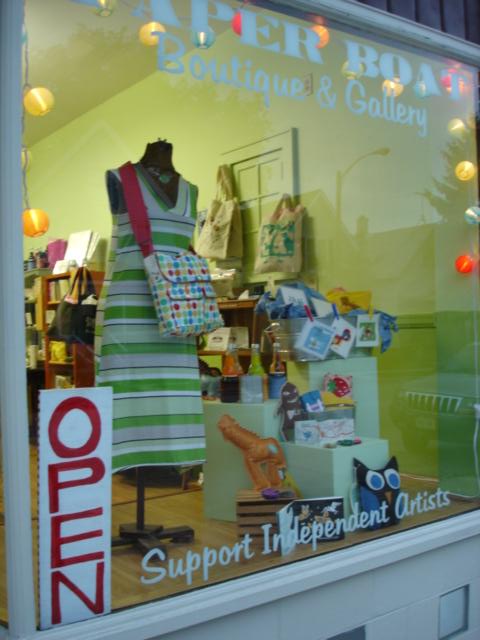Floating the Boat: Milwaukee Gallery Rides Wave of Local Artists
One in a series of letters from Minnesotans about art scenes in other places, this piece by Regan Golden-McNerney describes a Milwaukee gallery of interest to Minnesota artists.

I wanted to convey to my fellow Minnesotans that alternative art venues and rampant art making are going on all around us—literally—in Wisconsin, Illinois, and Iowa. This first article is dispatched from Milwaukee, Wisconsin.
Fluffy, kitchy, flowery and utterly revolutionary describes the artwork at Milwaukee’s Paper Boat Gallery and Boutique. Located on the cities’ Southside, just blocks from the port of Lake Michigan, the Paper Boat Gallery is a bridge between Northeast Minneapolis and Chicago’s Lincoln Square. Founded by Kim Kisiolek and Faythe Levine in June 2005, the Paper Boat now features the work of over a hundred artists from across the Midwest and beyond.
The artists work in many media—from the woodblock prints of “Lumberjack Lolitas” by Amanda Kindregan from Renton, Washington, to the latch-hooked rugs of pixilated internet porn images by Whitney Lee of Columbus, Ohio. The most interesting work at Paper Boat juxtaposes traditional modes of art practice, such as rug hooking, with contemporary art issues, such as the relationship between viewer and object in digital media. Lee, in particular, describes her work as an ironic feminist critique of the objectification of women in fashion magazines and soft-core pornography. This work marks a return to “outmoded” forms of art practice, as a powerful tool for critiquing the exploitative images and disposable objects generated in our consumer culture.
Why are artists in the Midwest picking up their knitting needles to make critical statements about culture?
One factor, according to Levine, is nostalgia for the days when more everyday objects were handmade. Unlike uniform, mass-produced objects, much of the work at Paper Boat emphasizes the quirkiness and individuality of handmade objects.
Another factor inspiring this art practice is the desire to make affordable handmade works of art. To achieve their goal, some artists work in recycled materials, such as bottle-cap magnets with tiny drawings of wildlife embedded in glass. According to Levine, making art accessible to many of the young artists and new families in the neighborhood is especially important. “One of my favorite moments is selling someone their first work of art,” says Levine, artist and co-owner of Paper Boat .
Levine and many other artists at Paper Boat also have been influenced by the DIY(Do-It-Yourself) ethic advocated by Ready Made, “a bimonthly magazine for people who make stuff.” There are also many websites and blogs devoted to making imaginative art objects out of ordinary materials. The Craftster site, for instance, recently sponsored a competition for the most interesting object made with hardware (the nuts and bolts kind) for under $10. My favorite was the menorah made of washers. These DIY art projects blur the line between art and craft, and also between low-tech and high-tech.
A defining feature of this movement is that artists working in traditional craft techniques find each other and organize over the internet. In 2003 Sue Blatt and Kathleen Habbley coordinated the first Renegade Craft Fair in Chicago to bring together artists who first met on the web. This is now an annual event in Chicago and has expanded to Brooklyn, New York. This event inspired Levine and Kisiolek to organize the Art vs. Craft Fair in Milwaukee every November. Last year the fair attracted over 150 artists and 2000 visitors. The success of the two fairs and the DIY movement inspired Kisiolek and Levine to launch the Paper Boat.
What impact will this new arts-crafts movement have on galleries and art institutions?
The Paper Boat Gallery and the DIY ethic add a sense of cohesion to an art market that tends to privilege the work of individual artists rather than the collective. For Levine, Paper Boat and the Art vs. Craft fair are about artists coming together to promote and support one another. Levine and Kisiolek also work closely with local women business owners to collaborate on publicity for special events. This is part of a neighborhood resurgence led by the feminist bookstore “Broad Vocabulary,” the Yarn Store “Loop,” and a sewing school run Milwaukee’s own “Fashion Ninja.” The result is an eclectic and vigorous community of artists.
Unlike more conventional gallery settings, the Paper Boat encourages visitors to handle the art—flip through hand-printed books and caress the felt “messenger” owls. While this approach to display is effective in a small gallery like Paper Boat, this is less feasible when art objects which blur the line between art and design are displayed in major museums, such the Walker Art Center’s exhibition Strangely Familiar: Design in Everyday Life (June 2003) or the Universal Experience: Art, Life and the Tourist’s Eye at the Museum of Contemporary Art in Chicago (February 2005). Displaying these souvenirs of everyday life and maintaining their critique of mass-production within the context of an art institution poses a challenge for artists and museums alike.
This nontraditional approach to the arts certainly seems to have its roots in Judy Chicago and Miriam Shapiro’s Womanhouse and the Fluxus movement (such as the work of John Cage and Yoko Ono). However, I think the Paper Boat Gallery reveals that succeeding as an artist in the Midwest requires unique strategies for art practice and a supportive arts community, but from this emerges equally innovative ideas about art and its definition. As Levine stated, “you can leave and go to New York or you can just create whatever you need for you and your city.”
I left Paper Boat with a pair of earrings made from laminated magazine pages, and a keen sense that a small local gallery in the heart of the Midwest can raise profound questions about the role of artists in society while blending the boundary between gallery and gift shop, art and craft.